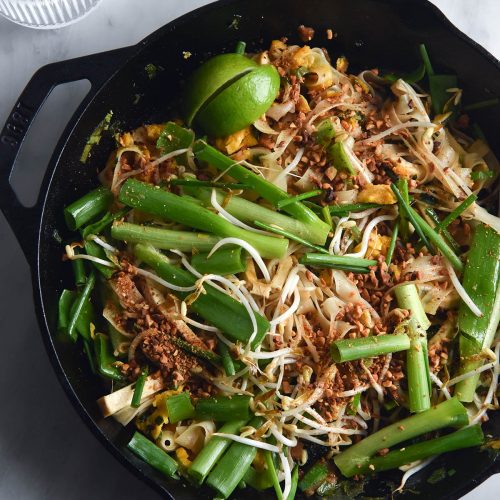
Low FODMAP Pad Thai (vegetarian, vegan option)
Vegetarian, vegan option, gluten free
Ingredients
For the sauce:
- 75-100 g palm sugar see notes and body of post
- 3/4 teaspoon Tamarind paste concentrate I used Jeeny’s brand, see notes
- 2-4 tablespoons vegan fish sauce highly dependent on the brand, see notes and body of post
- 1 teaspoon gluten free dark soy sauce see notes
For the Pad Thai:
- 125-150g Pad Thai rice noodles soaked for 1+ hours (see notes and body of post)
- 4-5 tablespoons vegetable or peanut oil don’t skimp or it will be dry
- 1/3 - 1/2 bunch spring onion greens half finely chopped and half in thumb sized slices for garnish
- 1 tablespoon garlic chives see notes
- 25g Thai sweet preserved radish see notes
- 2 extra large eggs whisked
- 50-100g extra firm tofu sliced into thin batons
- To finish
- Toasted chopped peanuts to finish
- Handful of bean sprouts to finish
- Extra garlic chives and thumb sized spring onion greens to finish
- Lime wedges to serve
Instructions
- Begin by submerging and soaking your rice noodles in cold water for at least an hour. You could be able to twist one around your finger without issue once they have softened.
- When the noodles are ready, drain them and set aside. Then, make the sauce by combining the palm sugar, tamarind paste, dark soy sauce and fish sauce in a small saucepan over a low-medium heat. Add the fish sauce conservatively to begin with. Cook the sauce until the sugar has melted and it begins to bubble up. Taste and adjust vigorously according to your preferences. This might mean adding more fish sauce, tamarind, palm sugar or even dark soy. Once you’re happy, set the sauce aside.
- Have all the remaining ingredients chopped and ready to go. Finely chop your spring onions, garlic (except the garnish ones) garlic chives and your preserved radish (I like to chop it and then throw it in my mini food processor to make it superfine). Whisk the eggs in a small bowl and chop the peanuts and garnishes.
- Heat the oil in a wok or skillet over a medium high heat. Once it is shimmering, add the spring onions, garlic chives and preserved radish. It should sizzle on impact. Stir to combine, then add the drained rice noodles.
- Stir well to coat the noodles in the hot oil. It can help to do a sort of side to side swishing with your spatula, or to use tongs.
- Add the Pad Thai sauce and stir to coat the noodles. Once they are coated and have softened, push them to one side and pour in the whisked eggs. Move the egg around to thin it out a little – this will ensure it all cooks. After about 30 seconds (or when your eggs are opaque but still soft) stir to incorporate them into the noodles. Break up any large chunks if there are any.
- Add the tofu and stir gently to combine. Heat the tofu through, then take the Pad Thai off the heat. Stir in a big handful of bean sprouts and top with the leftover spring onion greens and toasted peanuts. Plate the two serves up and finish with extra peanuts and wedges of lime.
Notes
- Vegan fish sauce brands vary hugely in their flavour and saltiness. I have tested Niulife (which I needed 4-5 tablespoons of) and Vincent Vegetarian (which I needed 2 tablespoons of). You will need to make the sauce according to the brand you have and also according to your tastes! Some people like a pronounced fishy flavour and some don’t.
- Tamarind paste and the block of tamarind that needs to be soaked are very different. I have only tested the paste thus far. I will update the post when I try to block.
- Dark soy sauce adds colour and a bit of salt to your Pad Thai. You might find that your fish sauce is salty enough and that you don’t need it. Without the dark soy, your Pad Thai might be a little light in colour, but no less delicious.
- If you can’t find garlic chives, I have had some success with regular chives. Alternatively, you could try adding extra spring onion greens.
- If you can’t find Thai sweet preserved radish, you can use the Japanese variety or omit it.
Tried this recipe?Let us know how it was!